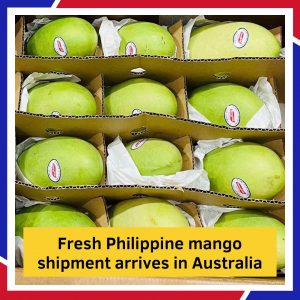Australia has strict food safety regulations and standards as part of its broader biosecurity policies to protect the country from the many pests and diseases that can be spread by international agricultural trade, as well as ensure that food products entering Australia are safe for human consumption.
The Australian government is zealously protective and committed to the safety of Australian food supply and all imported food must meet Australia’s strict biosecurity requirements to be allowed into the country.
As such, Philippine exporters may find it difficult to comply with Australia’s import quarantine requirements. Over the past three years, a number of exporters have been found non-compliant with the import requirements resulting to the destruction and/or re-export of the products out of Australia.
On average, the Philippine Embassy in Canberra receives 10-15 failed food notifications per year from Australia’s Department of Agriculture, Water and Environment (DAWE) informing the Philippine government that some food products from the Philippines have failed quarantine inspections conducted under the Australian government’s Imported Food Inspection Scheme (IFIS).
The reasons for failure include histamine levels, commonly found in dried herring products, that have been detected in excess of the 200 mg/kg level permitted; aflatoxin levels, commonly found in peanuts and peanut-based products, in excess of 0.015 mg/kg level permitted; chemicals such as profenofos detected in jute leaves in excess of the Maximum Residue Limits (MRL) in Australia, as well as compositions such as vitamins, food colourings and additives that are not allowed in Australia.
To prevent similar circumstances from occurring and protect the Philippines’ credibility as a supplier of high-quality food products, the Export Marketing Bureau (EMB) together with the Philippine Trade and Investment Center (PTIC) in Sydney conducted a consultation meeting with the Food and Drug Administration (FDA) on 3 November 2021 aimed at understanding the factors affecting PH exporters’ compliance with Australia’s biosecurity requirements and identifying relevant agencies to assist PH exporters in complying with the requirements.
During the meeting, the FDA highlighted the responsibility of manufacturers and exporters to to comply with the Philippines’ Food Safety Act of 2013 which sets out the food regulations, standards, and control of food safety risks in the food supply chain. The EMB also underscored the importance of observing Good Manufacturing Practices (GMP) and other rigorous certifications and evaluations of goods from the catch (for seafood products) or farm (for agricultural products) all the way to production, packing, storage, handling, and shipping of goods for exports.
Meanwhile, the participants agreed that a series of consultations with the manufacturers, exporters, consolidators, freight forwarders and other regulatory agencies such as the Department of Agriculture and Bureau of Fisheries and Aquatic Resources would be the next logical steps as we continue to work on improving our compliance with Australia’s IFIS.
For the guidance of manufacturers and exporters, the following information might be helpful:
- Food entering Australia is subject to the Imported Food Control Act 1992 and the Imported Food Control Regulations 2019. Under this legislation imported food is inspected and controlled using a risk-based border inspection program called the Imported Food Inspection Scheme (IFIS), which is administered by the Department of Agriculture, Water and the Environment (DAWE).
- Australia’s food standards are contained within the Australia New Zealand Food Standards Code (the Code), which is administered by Food Standards Australia New Zealand (FSANZ).
- Australia monitors compliance to the Code under the IFIS, which classifies food as either a risk food or surveillance food. Testing may be applied under the IFIS and the procedures are published in Tests applied to risk food and Tests applied to surveillance foods
- Risk food – Risk food is identified by FSANZ as a food that presents a potential medium or high risk to public health
Example: fish and fish products Imported food risk statement for fish and fish products from the families specified and histamine. Of note in the report which manufacturers of dried herring should look into is that: storage conditions and temperature control during and after capture that supports bacterial growth. The length of time and the temperature in which fish are stored, are extremely influential on the level of bacterial growth and subsequent histamine level in the fish (Lehane and Olley 2000; Baixas-Nogueras et al. 2009; Torido et al. 2012; Visciano et al. 2012; Cheong et al. 2014).
For more information on risk food, testing and sampling refer to Imported Food Notice 07-18 – Food sampling under the Imported Food Inspection Scheme and tests applied to histamine susceptible fish.
- Surveillance food -imported food that is assessed as not posing a potentially high or medium risk to public health is classified as a surveillance food.
Under the food legislation, five percent of surveillance food is randomly selected for border inspection and analysis to verify compliance with the Australia New Zealand Food Standards Code and its safety. The inspection includes a visual check and label assessment. Samples may also be taken for analyses against a range of microbiological and chemical hazards.
A recent failing food email notification sent to the Philippines related to the apple juice drink due to Zinc lactate and Vitamin A palmitate not permitted in this food. Under Food Standards Code: 1.3.2, a food (or drink) that is fortified and produced by an offshore manufacturer may meet actual or potential population health needs offshore but may not be permitted for consumption by Australian consumers.
- Food that fails inspection – importer must advise whether the food will be re-exported, destroyed or treated (if applicable such as re-labelling). More information can be accessed on the DAWE website – What happens if my food fails inspection?
- Failed food reporting – foods that fail border inspection are published in Monthly Failed Food Reports which are available on the DAWE’s website
For any additional questions or concerns, exporters may send an email to PTIC-Sydney at sydney@dti.gov.ph. ♦
Date of Release: 11 November 2021






